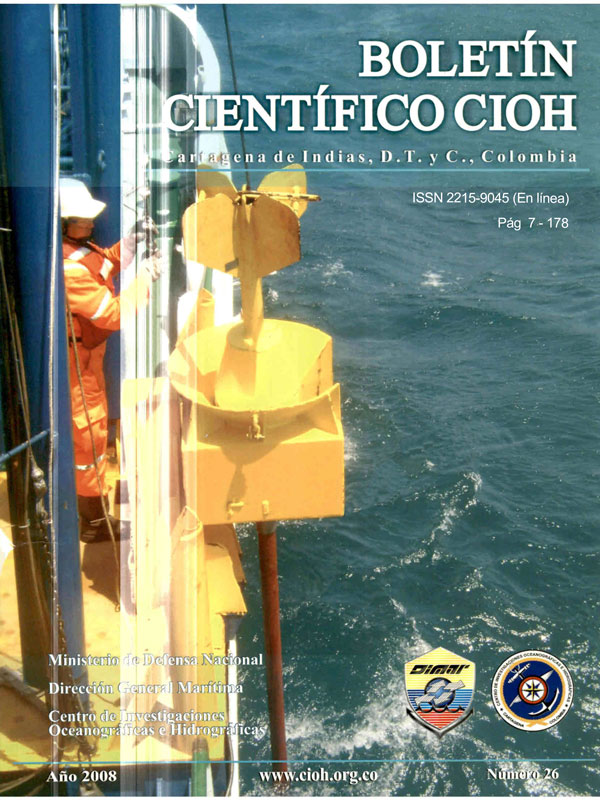Adjustment of thermohaline structure in a numerical model through satellite data assimilation
DOI:
https://doi.org/10.26640/22159045.174Keywords:
Satellite data assimilation, sea level, dynamic topographyAbstract
Using the sea level static assimilation technique, the thermohaline structure of an oceanic circulation numerical model is modified, which permits the inclusion of satellite data with sea level anomalies on the baroclinic fields. The oceanographic cruiser “Caribe October 2007” was planned with the specific purpose of making in-situ measurements coinciding with the surface track and close times of two passages of satellite JASON-1 over the Colombian Caribbean. The simultaneous measurements of the ocean temperature and salinity, together with the sea level obtained from the satellite, make possible the restoration of the density variations of the water column. The Princeton Ocean hydrodynamic Model (POM) was used to filter the ocean climate patterns, and to reveal the anomalies related with the synoptic state. The article proves the possibility of assimilating the thermohaline fields using the absolute dynamic topography measurements from satellites.Downloads
References
[2] Lonin S A, Anduckia JC. Asimilación de anomalías del nivel del mar en el Sistema de Predicción Oceánica de DIMAR. Boletín Científico CIOH 2004; ( 22) 26-35.
[3] Fox A, Haines K,de Cuevas B, Webb D. Altimeter assimilation in the OCCAM global model, Part I: Atwin experiment, Journal of Marine Systems. 2000; (26): 303-322.
[4] Fox A, Haines K, de Cuevas B, Webb D. Altimeter assimilation in the OCCAM global model, Part II: TOPEX/POSEIDON and ERS-1 assimilation, Journal of Marine Systems. 2000; ( 26): 323-347.
[5] Fox A, Haines K. Interpretation of Water Mass Transformations Diagnosed from Data Assimilation.Journal of Physical Oceanography. 2003; (33): 485-498.
[6] Lonin S, Anduckia JC, Parra C, Molares R. Modelo de circulación oceánica con asimilación de datos para el Caribe aplicado en derrames de hidrocarburos, pesquería y búsqueda y rescate. En el libro: Contribución en las Ciencias del Mar en Colombia. Universidad Nacional de Colombia. 2003; 103-120.
[7] CIOH. Implementación de un sistema de pronóstico oceánicos y atmosféricos a escala local en el Caribe y Pacífico colombianos SPOA. Fase I, Informe final del año 2007; 2007.
[8] Romero C, Marriaga L, Torres R. Metodología para la calificación y control de calidad de datos oceanográficos aplicada al Crucero Caribe 2002. Boletín Científico CIOH 2007; (25): 78-93.
[9] Lonin SA. Empleo de los datos de la NOAA-NODC-WOAen el modelo hidrodinámico del Caribe. Boletín Científico CIOH 2004; (22): 45-55.
[10] Levitus S. World Ocean Atlas 2001, NOAAAtlas NESDIS 54, Silver Spring, MD. 2001.
[11] Da Silva AM, Levitus S. Atlas of Surface Marine Data 1994. NOAAAltas NESDIS 6, Wash., D.C.;1994.
[12] Mellor GL. User's Guide for a Three-Dimensional Primitive Equation Numerical Ocean Model, Princeton, NJ, 35 p. ; 1993.
[13] Anduckia JC, Lonin SA, Ivanov SV. Asimilación de datos de temperatura superficial del mar en el modelo hidrodinámico de pronóstico de las condiciones oceanográficas del mar Caribe. Boletín Científico CIOH 2003; ( 21): 38-50.
Downloads
Published
Issue
Section
License
Attribution — You must give appropriate credit, provide a link to the license, and indicate if changes were made. You may do so in any reasonable manner, but not in any way that suggests the licensor endorses you or your use.
NonCommercial — You may not use the material for commercial purposes.
NoDerivatives — If you remix, transform, or build upon the material, you may not distribute the modified material.
No additional restrictions — You may not apply legal terms or technological measures that legally restrict others from doing anything the license permits.



